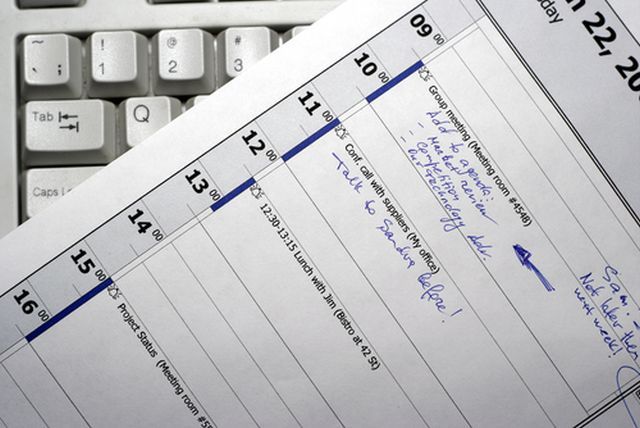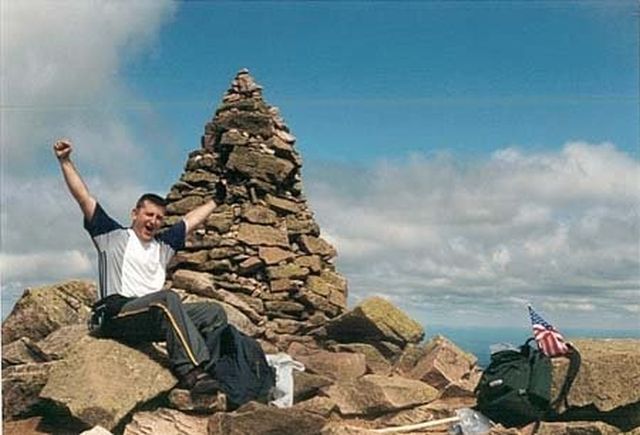William Blake once wrote, "Great things are done when men and mountains meet." Climbing mountains can teach you a lot about life, but no area more so than time management.
Time is precious. Everyone's day has 24 hours. No more and no less. So how you tackle those 24 hours can make the difference between a wasted day, or a day you can be proud of.
How you manage your time from the first moment you get up in the morning, to the last moment when you go to bed at night, is a lot like mountain climbing. I learned these lessons the hard way, and I've applied them to my life with great success.
Let me share some of those with you, and you won't even need to climb a single mountain to apply them to your own life!
1. The Short Way Is Not Always the Fast Way
Many times, mountains are a bit of an optical illusion. When you look at the many paths that are available to get to the top, you may be tempted to take the shortest -- hoping to get to the top faster.
It's an amateur mountain climber's mistake -- ignoring the elevation lines on the map.
My wife (at the time, my girlfriend) and I learned this lesson the hard way when we planned an overnight camping trip at the top of a mountain in Western Massachusetts. We chose what we thought was a "short" three mile hike to the campground. As it turned out, the three miles was almost entirely up a steep grade.
It took us a good part of the day to reach the top wearing two fully loaded camping backpacks. Looking at the map more closely later, I realized we could have taken a five mile trail that traversed a gradual slope along a ridge, and we would have arrived at the same spot a couple of hours sooner.
The "Long Way" in Time Management
Applying this to time management is easy. When you're planning tasks into your schedule, people will often place entire tasks -- regardless of their complexity or difficulty -- into the schedule, assuming they'll work out what needs to be done as part of the work itself.
This is the wrong approach. This is basically saying that you're going to try and climb 100 giant boulders all in a single session to get to the top of that mountain.
It's smarter to take the "long way" to the top, by spending a little bit of extra time at the beginning to break down those really important, complex projects into smaller bite-sized pieces. Provide each of these pieces with your best estimate of how long they're going to take.
Then, when planning out your workday, you can select only one task from this list and put it into a slot in your schedule where you feel reasonably confident that you can accomplish it.
By taking this gradual approach to finishing projects, you're ensuring that you won't get bogged down and overwhelmed by the complexity of the task. This only appears to be the long path to project completion, but it'll actually get you there much faster.
2. It May Be Sunny Now, But Bring Rain Gear
If you're a hiker, then you've probably been on one of those trips where you start out hiking in the warm sunshine, and before you know it you're crouched underneath the trees in a torrential downpour. The weather forecast said nothing about rain, so you failed to bring a raincoat or even a plastic emergency poncho.
It ain't fun.
Don't let the pleasant weather of today fool you. This same lesson can be applied when you're planning your week.
Bring Rain Gear Into Your Schedule
The most common thing people do when they sit down at the start of the week to put together their schedule, is to stack each day up with tasks, back-to-back. It's very easy to do this on a Sunday night when all is calm and it isn't raining a crisis.
That all changes once the week starts. So what's your "raincoat" against the crisis thunderstorm? Time cushions.
In an interview with Entrepreneur, time management expert Julie Morgenstern described these time cushions.
"You shouldn't overschedule yourself. You don't want to schedule everything down to the minute because something unexpected always comes up. That's the one thing you can count on. So you need to build time cushions in..."
Julie recommends using an alternating approach. Schedule one planned hour of work followed by one unplanned hour of work. This leaves gaps -- or time cushions -- that can absorb the "rain" when someone calls and needs something from you immediately. Just keep plugging away at that planned work in between each crisis.
If there's no crisis and you finish the task early, you can move on to your next scheduled task in the schedule.
3. Don't Underestimate the Mountain
When I'm hiking some of the tallest mountains in New England, I never fail to see weekend tourists walking on the trails wearing tennis shoes and carrying a single bottle of water. Sometimes I wonder how long it'll be before I pass them again on the trail, completely dehydrated and wondering how they got themselves into this mess.
Underestimating a mountain can be a recipe for disaster. It isn't really something you can explain to someone -- you have to go through the nightmare of experiencing it to truly understand just how terrifying it can be.
The biggest problem that people run into when trying to stick to a schedule is in not estimating the time it's going to take to complete a project or a task.
Properly Estimate Time for Tasks
Even if you take the advice offered above, and break down huge projects into "bite-sized" pieces, it's still important that you are accurate with the work estimate required for each piece, otherwise you spend far too much time on them and get completely lost inside your schedule.
So how do you accomplish this? Believe it or not, the best advice here doesn't come from some time management guru, it comes from Microsoft, on their MS Office Support site.
To estimate how long tasks will really take, Microsoft suggests that you use one or more of the following four sources.
- Your own experience: If you've done the task often enough before, then base your estimates on the actual time you've spent doing the same task before.
- Team members: Most of us work on teams where other people often have to perform the same tasks as you. Ask around and get some idea how much time other people spend on these tasks, and average them out for your own estimate.
- Previous projects: Reviewing any documented projects that your team might have worked on in the past can give you some idea how much effort those tasks will take.
- Industry standards and benchmarks: Google is your friend. If you're planning to work on a fairly common task, don't be afraid to Google, "How long does it take to xx?"
It's important to take the time to do this research, because the worst thing you can do to your time management plan is underestimate difficult tasks. Once you've blown an entire day working on a task that you thought would only take a couple of hours, you've done some major damage to your entire schedule, and it can take a long time to recover from that.
4. Pace Yourself for Distance
When you're diving into your schedule, take the same approach as you would if you were starting out running a marathon. You wouldn't go into an all out sprint at the very start, right?
Die hard mountain climbers learn this early in their hobby. If you start out the hike at full-bore during just the three-mile hike to the base of the mountain, you won't have any energy left for the hardest part of the hike.
The same can be said for nearly any major task that you need to accomplish in life. Pacing yourself is everything.
Businesswoman and author Marissa Mayer once wrote:
"I pace myself by taking a week-long vacation every four months."
This is a perfect, simple way to look at pacing. You can apply it to your schedule by shrinking it down into smaller pieces of time. Instead of four months of work followed by one week of rest, consider a six day work week and one full day off. Or how about three dedicated working hours, followed by one hour of rest or "free time"?
Or you could take it right down to the extreme Pomodoro technique of working for 25 minutes, followed by a 5 minute break.
The idea here is that you are not trying to power through an entire eight-hour workday without any rest, and burning yourself out in the process.
5. Avoid Focusing on the Whole Mountain
One of the most memorable hiking trips I've ever been on was one where a buddy and I had spent a total of nine hours climbing to the first peak of a mountain range.
By the time we hit the first peak, I was completely wasted. My thigh muscles were in spasms, and all my energy was gone. All the usual self-doubt thoughts were going through my head. I wasn't in shape enough for this. I couldn't make it. I should turn around and give up.
We reached the top of the mountain, and I just stood there with my jaw hanging open, gazing out across the jagged expanse from one mountain peak to the other -- traversing four summits.
I was ready to curl up and die. I sat down on a stone, and put my head in my hands. My friend sat down next to me, and said something that I'll never forget.
"Don't look at the whole mountain. Just look at what's in front of you. Once we do that, we'll look at what's next. We'll get there eventually....hey, we have all day!"
It was enough motivation to get me back up on my feet again. We forged ahead, and taking the mountain one small piece at a time, we made it. The same can be accomplished in your own life.
Manage Your Goals, Then Let Them Go
Some people jump into a new time management system in full force and with all of the gusto they can muster. They create all of their life goals, break them down into a bunch of smaller parts complete with dozens of tasks each.
Once that's all done, the sheer size of the task list alone is enough to make even the most resilient worker run away screaming. The whole thing can feel insurmountable.
The way around this is to use the motto "set it and forget it" with goals. You should only be reviewing your goals either every six months, or yearly. But once you've created those goals, put them away and only focus on the tasks you've created to accomplish those goals.
The tasks should be broken up into smaller sections, and only the tasks that need to be accomplished within the year should be on you current list. The rest can wait until next year to be planned out.
Now that you have a smaller chunk to work with, break those list of tasks for the year into smaller groups of things to accomplish each month. Take the list for this month, and set aside all the rest. Now your list of projects is looking much more manageable, right?
The psychology behind this technique is very powerful, and over time, you can accomplish things you never imagined possible by using it.
6. Avoid the Pebble in Your Shoe
There's something in your shoe. It is one of the hardest things to deal with when you're trying to walk on a woodland trail. It doesn't matter if you are walking on a flat, well-groomed path or climbing over huge boulders, when there's something hard grinding into your foot -- the entire hike can become unmanageable.
Worse, it can lead to irritated skin, blisters, and even a sprained ankle.
Muhammad Ali once commented,
"It isn't the mountains ahead to climb that wear you out; it's the pebble in your shoe."
Truer words were never spoken.
Get Rid of Unnecessary Tasks
What are the pebbles in your shoe when you're trying to manage your time?
The reality is, some tasks that you included when you were first brainstorming turn out to be completely unnecessary. Just because you have a task on your to-do list doesn't mean that you can't re-evaluate things and ask yourself: Is this task really necessary to accomplish your goal?
If it isn't -- or if there's some other, simpler way around it -- by all means, remove the task and move on.
7. Leave Time to Recover
Whenever a mountain climber is planning out a trip, they always leave a few days at the end of the vacation for "recovery". The hike is going to be hard, there's no sense in trying to go into work the next day when you're so sore that you can barely climb out of bed.
Schedule in Time to Rest
In addition to pacing yourself, as described at the start of this article, don't forget to include enough time at each of your major milestones to fully recover from all of the hard work that you've done.
Vacations are important. They not only rest your body, but more importantly they help reset the "palate" of your mind, so that you can return and tackle the new tasks in your schedule with renewed vigor and passion. Don't leave this part out, it's probably more important than all of the rest!
Are you a mountain climber? Have you ever applied the things you've learned on the trail to your own time management and productivity toolbox? Share your own tips and advice for others in the comments section below!
ClimberJAK via Shutterstock, David Mail via Shutterstock, Diego Cervo via Shutterstock, iQoncept via Shutterstock, Nejron Photo via Shutterstock











